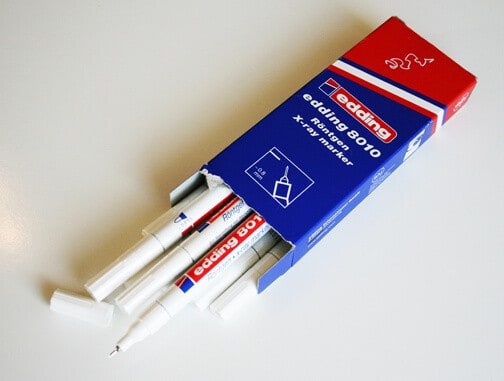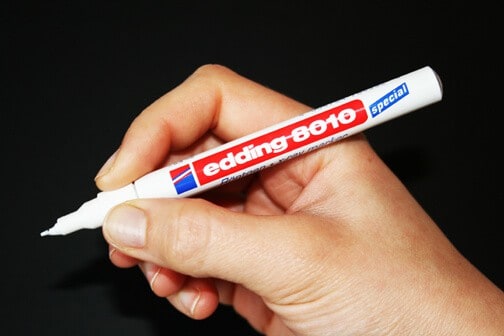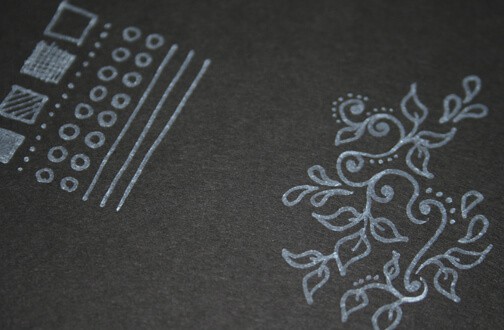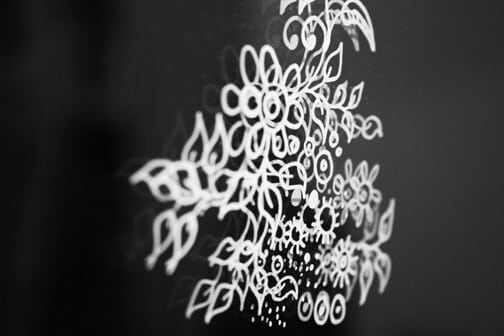31st January 2011
Pen Geek 2 : Edding 8010 Rontgen X-ray marker
A few months ago a mysterious package arrived in the post from @Adamstjohn – one of those brilliant people you come across on Twitter, (I seem to recall he suggested “a PowerPoint presentation featuring a bra” in my first ever TwitterPicture). Needless to say his kind act of inky generosity was most graciously received.
Ink : White, opaque, permanent pigment ink. Quick drying, lightfast, especially suited for rub and water resistant marking of X-ray films.
Nib : Round tip
Size : 0.8mm
Cap : Removable.
Manufacturer : Edding
RRP : £5.40 each (approx)


The obvious starting point is that these pens use white ink and not my usual black. This dictates not only the
colour of your drawing surface (white on white is beautiful but very subtle) but also the way you draw; is the negative space the ink or the paper? Do you work invertly because the ink is white and the paper black? It’s a parallel universe of drawing.
After getting over my initial musings about the white ink, it was time to get drawing. The ink barrel of the pen contains a mixing ball which you need to shake up prior to use to get the ink flowing – you’ll hear the ball rattling inside the pen. Always shake with the lid on. I once shook an uncapped Posca marker to disastrous effect. After shaking it up, remove lid and pump the nib up and down onto some scrap paper a few times, it will retract back up into the barrel of the pen and help pull the ink down. Initially the ink comes through translucent, then moves to a thick opaque white as the newly blended stuff starts to flow through.
First off I tried the pen on some heavy black card. The ink was drunk up by the porous surface of the card, leaving just a very washed out tracery of white. It definitely wasn’t opaque.

These pens were developed for the medical industry, for doctors to mark x-rays with. Due to a disappointing lack of X-rays in my studio, I started hunting for similar smooth, glossy surfaces. THIS is when these pens are in their element! Initial tests on black glossy, plastic coated papers provided wonderful results. The ink glides over the smooth surface and sits there, completely opaque. More tests on similar surfaces proved that these pens would also work on photographs, mirrors and glass.

The ink flows through fairly fast, so avoid long pauses if you don’t want little blobules of white and a steady, light pressure is required to prevent the nib accidentally retracting back into the pen and causing a puddle. The ink sits slightly proud of the drawing surface and takes about 30 seconds to really dry, so bear this in mind to avoid smudging and scuffing.
The nib and ink type doesn’t lend itself well to intricate detail, but nothing more tricky to handle than your average 0.8 fine liner.
Filling in areas is a breeze, there’s so little friction between the ink coated nib of the pen and the smooth surface that the pen just glides back and forth, effortlessly block filling in thick white ink.
All in all, if you need to draw on a dark, glossy surface, these little beauties will do you justice. Once you have adjusted your pressure on the nib and drawing speed, the ink is easy to control and -in all honesty- lovely to draw with, so smooth it feels like you are just gliding over your drawing.
A very material specific pen, but definitely one to try out! Off to think up a suitable project to use them on….














